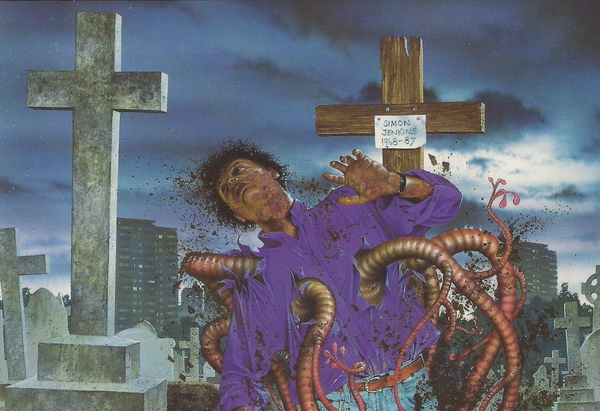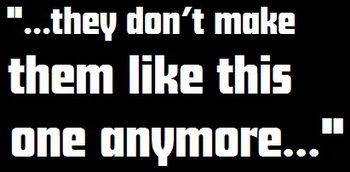|
| |
|
STORY PLACEMENT THIS STORY TAKES PLACE BETWEEN THE
NOVELS "THE DEATH OF SIN."
WRITTEN BY RUSSELL T. DAVIES
RECOMMENDED PURCHASE OFFICIAL VIRGIN 'NEW ADVENTURE' PAPERBACK (ISBN 0-426-20483-2) RELEASED IN OCTOBER 1996.
BLURB The Doctor, Chris and Roz arrive at the Quadrant, a council block in Thatcher's Britain.
There's a new drug on the streets; ONE that's killing to a plan. Somehow, the ordinary people of the Quadrant are involved. And so, amidst the growing chaos, a bizarre trio
moves into number 43.
dead drug dealer has risen from the grave and an ancient weapon is HIDDEN BY human tragedy. BUT the Doctor soon FINDS that the things people do for their children can be every bit as deadly as any alien menace... |
|
|
Damaged Goods OCTOBER 1996
Damaged Goods is one of the most inventive and memorable Doctor Who novels that I’ve ever come across. Too broad and too deep for the small screen in more ways than one, Russell T Davies’ observant novel truly lives up to the New Adventures mantle of taking the TARDIS into previously unexplored realms of space and time.
For me, some of the best New Adventures have been those penned by Andrew Cartmel. Each of his novels has been a gritty, hard-hitting tale set in the near future, usually stateside. Cartmel’s books have an indelible sense of reality about them; his characters are all so real that the reader becomes completely immersed and so inevitably, once the strange goings on start… well, going on… everything seems that much more frightening. That much more accessible. And now, with Damaged Goods, Davies has created the British equivalent of Cartmel’s three War novels.
Opting for the recent past rather than the near future, Davies’ story is replete with the familiar - troubled council estates, drugs, Thatcher’s Britain; you name it. Take the inhabitants of ‘the Quadrant’, Davies’ fictional council estate. We have Bev Tyler and her Mum - a single parent family with a twist. We have Eva – the ‘haughty bitch done good’ but still can’t get what she wants because (or at least, she thinks, because…) of one youthful indiscretion. And then we have Harry and David who share one of the oddest, most twisted relationships I’ve ever read about. They’re like something out of an Irvine Welsh paperback, only English and gay. Now because I am of the deprived generation that almost missed out on televised Who entirely, even the Doctor’s adventures set in the series’ ever-mutable present always seemed slightly too far removed for me. But Damaged Goods, like just a handful of New Adventures before it, I can relate to entirely. It’s like Survival with the volume turned up. What we have here is a suburban nightmare with characters so abhorrently credible that they’ll make you want to emigrate. It’s brilliant.
For a lot of readers though, I’d imagine that Davies’ explicit and adult character stories will turn them off this book. I couldn’t really imagine purists who grew up watching Billy Hartnell and Pat Troughton relishing Chris getting bent over, and so in a way Damaged Goods is its own worst enemy because it’s almost too real. Too seedy. Too depressing. But what I liked – what really endeared both this book and its author to me – was that it isn’t full of senseless gratuity. If you look at Harry and David, for example, there’s a character story there that is really quite sad; tragic, even. And, looking at it in a more detached way, there’s a character story there that’s integral to the plot. And don’t be fooled by the naysayers, there is a plot here. Perhaps the best plot that this ‘psi-powers’ arc has come up with by a long, long way, in fact.
to the N-Form – an ancient Time Lord weapon that was used to purge our universe of the Great Vampires. Now I won’t pretend to know how on Earth the events of this novel link in with those that I’ve begrudgingly trawled through in recent months, but I do know that Davies has taken these shabbily-connected novels and managed to make them feel like they are part of something epic. As if the N-Form isn’t enough in itself, Davies also drops in some lovely, subtle little touches like having the N-Form reactivate due to a signal from the future, as opposed to the past, implying that there is another great war to come. It all ties in beautifully with Goth Opera and this idea that the Time Lords’ future as unforeseeable and as uncertain as anybody else’s.
On balance though, the thing that sticks in my mind the most about Damaged Goods is the human element. The back stories. The tragedies. The ‘extras’ in the Doctor’s life, as Davies so expressively brands them. Renowned for writing character well, it’s little surprise that Davies has populated Damaged Goods with a whole host of strong characters, but he has actually done more than that. His seventh Doctor is portrayed astonishingly; he’s almost his own antithesis. He’s not pulling the strings. He’s not plotting and scheming. Don’t worry, it isn’t mischaracterisation on the author’s part – Davies’ seventh Doctor would love to play the master manipulator, it’s just that he can’t. He can topple empires, rewire spaceships and defeat monsters... but he simply can’t get his head around a late 1980s council estate. The mundane intricacies of its workings elude him completely.
And so this ‘award-winning television dramatist’
appears to have made the transition to
the printed word seamlessly. Damaged Goods is laden with beautiful,
evocative prose and the story is clever, compelling and controlled. Highly
recommended indeed.
|
|
|
Copyright © E.G. Wolverson 2006
E.G. Wolverson has asserted his right under the Copyright, Designs and Patents Act, 1988 to be identified as the author of this work. |
|
|
And so it came to pass that in late 2003, Russell T Davies would be announced to the world as the man to re-invent Doctor Who for the 21st century, and boy did he. Now that he’s moving on to pastures new, leaving the reigns in Steven Moffat’s capable hands, I felt that this would be an appropriate juncture to look back on Davies’ inaugural contribution to the world of Doctor Who - his controversial 1996 novel, Damaged Goods.
pieces in this novel remind me of the television show that half the nation now watches religiously every Saturday night. A family called ‘the Tylers’; the familiar backdrop of a Council Estate; the vague idea of this epic, unseen ‘War’; even a baddie who looks like Neil Tennant, the man the actor playing the tenth Doctor stage-named himself after!
“Once I’d started, I never stopped... I even wrote a Doctor Who novel in which the six-foot blond, blue-eyed companion interrupts the hunt for an interdimensional Gallifreyan War Machine to get a blowjob in the back of a taxi. Like you do.”
In the many interviews that Davies has given since the publication of Damaged Goods, he’s made quite a few attention-grabbing, if not terribly reverent remarks about his sole literary offering. It seems that all the gay stuff was just gratuity after all and, worse still, Davies didn’t mastermind the ‘psi-powers’ arc to an epic finale - he decided to keep it vague and hope that “someone else would made sense of it”! That’s me told.
In all
seriousness though, I’d quite like to know what Davies
really thinks
about his only novel to date as I’m still quite fond of it, and I
suspect that he is too – it doesn’t take x-ray vision to spot N-Forms in
the recent Doctor Who Annual, playing their part in the Davies’
Last Great
Time War. It’s such a shame that a plethora of hit television shows has
prevented Davies from ever writing any other Doctor Who novels as
one thing is for certain – they don’t make them like this one anymore...
|
|
|
Copyright © E.G. Wolverson 2008
E.G. Wolverson has asserted his right under the Copyright, Designs and Patents Act, 1988 to be identified as the author of this work. |
|
|
Unless otherwise stated, all images on this site are copyrighted to the BBC and are used solely for promotional purposes. ‘Doctor Who’ is copyright © by the BBC. No copyright infringement is intended. |
|

.jpg)
.jpg)
 Damaged Goods
Damaged Goods
 It’s astonishing
how many little bits and
It’s astonishing
how many little bits and